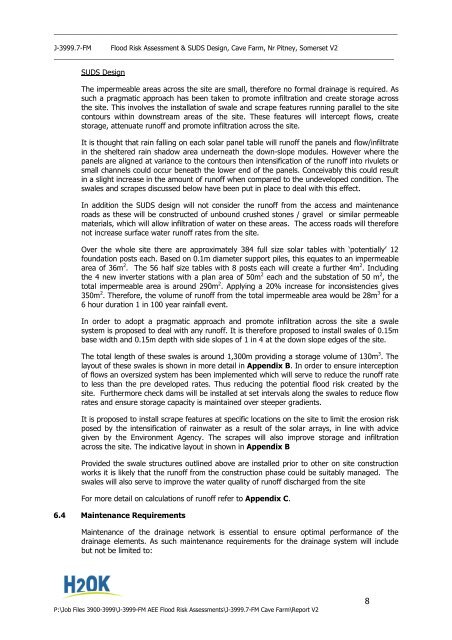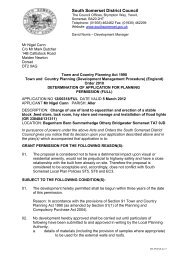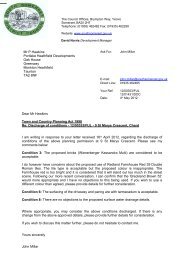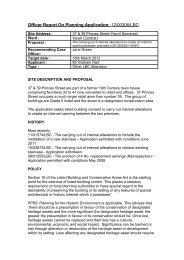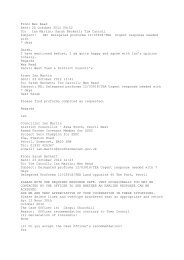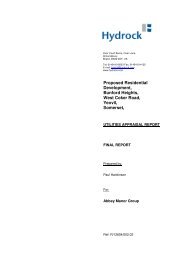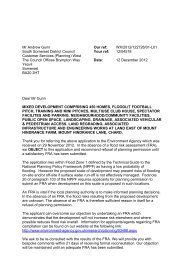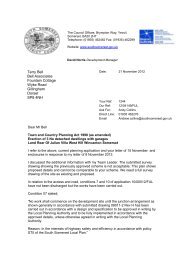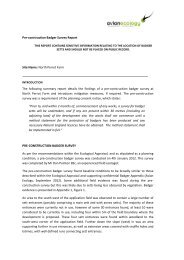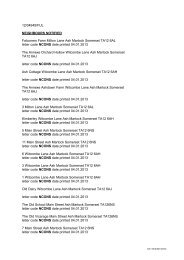proposed solar park development at cave farm, nr pitney, somerset ...
proposed solar park development at cave farm, nr pitney, somerset ...
proposed solar park development at cave farm, nr pitney, somerset ...
You also want an ePaper? Increase the reach of your titles
YUMPU automatically turns print PDFs into web optimized ePapers that Google loves.
____________________________________________________________________________________________<br />
J-3999.7-FM Flood Risk Assessment & SUDS Design, Cave Farm, Nr Pitney, Somerset V2<br />
___________________________________________________________________________________________<br />
SUDS Design<br />
The impermeable areas across the site are small, therefore no formal drainage is required. As<br />
such a pragm<strong>at</strong>ic approach has been taken to promote infiltr<strong>at</strong>ion and cre<strong>at</strong>e storage across<br />
the site. This involves the install<strong>at</strong>ion of swale and scrape fe<strong>at</strong>ures running parallel to the site<br />
contours within downstream areas of the site. These fe<strong>at</strong>ures will intercept flows, cre<strong>at</strong>e<br />
storage, <strong>at</strong>tenu<strong>at</strong>e runoff and promote infiltr<strong>at</strong>ion across the site.<br />
It is thought th<strong>at</strong> rain falling on each <strong>solar</strong> panel table will runoff the panels and flow/infiltr<strong>at</strong>e<br />
in the sheltered rain shadow area underne<strong>at</strong>h the down-slope modules. However where the<br />
panels are aligned <strong>at</strong> variance to the contours then intensific<strong>at</strong>ion of the runoff into rivulets or<br />
small channels could occur bene<strong>at</strong>h the lower end of the panels. Conceivably this could result<br />
in a slight increase in the amount of runoff when compared to the undeveloped condition. The<br />
swales and scrapes discussed below have been put in place to deal with this effect.<br />
In addition the SUDS design will not consider the runoff from the access and maintenance<br />
roads as these will be constructed of unbound crushed stones / gravel or similar permeable<br />
m<strong>at</strong>erials, which will allow infiltr<strong>at</strong>ion of w<strong>at</strong>er on these areas. The access roads will therefore<br />
not increase surface w<strong>at</strong>er runoff r<strong>at</strong>es from the site.<br />
Over the whole site there are approxim<strong>at</strong>ely 384 full size <strong>solar</strong> tables with ‘potentially’ 12<br />
found<strong>at</strong>ion posts each. Based on 0.1m diameter support piles, this equ<strong>at</strong>es to an impermeable<br />
area of 36m 2 . The 56 half size tables with 8 posts each will cre<strong>at</strong>e a further 4m 2 . Including<br />
the 4 new inverter st<strong>at</strong>ions with a plan area of 50m 2 each and the subst<strong>at</strong>ion of 50 m 2 , the<br />
total impermeable area is around 290m 2 . Applying a 20% increase for inconsistencies gives<br />
350m 2 . Therefore, the volume of runoff from the total impermeable area would be 28m 3 for a<br />
6 hour dur<strong>at</strong>ion 1 in 100 year rainfall event.<br />
In order to adopt a pragm<strong>at</strong>ic approach and promote infiltr<strong>at</strong>ion across the site a swale<br />
system is <strong>proposed</strong> to deal with any runoff. It is therefore <strong>proposed</strong> to install swales of 0.15m<br />
base width and 0.15m depth with side slopes of 1 in 4 <strong>at</strong> the down slope edges of the site.<br />
The total length of these swales is around 1,300m providing a storage volume of 130m 3 . The<br />
layout of these swales is shown in more detail in Appendix B. In order to ensure interception<br />
of flows an oversized system has been implemented which will serve to reduce the runoff r<strong>at</strong>e<br />
to less than the pre developed r<strong>at</strong>es. Thus reducing the potential flood risk cre<strong>at</strong>ed by the<br />
site. Furthermore check dams will be installed <strong>at</strong> set intervals along the swales to reduce flow<br />
r<strong>at</strong>es and ensure storage capacity is maintained over steeper gradients.<br />
It is <strong>proposed</strong> to install scrape fe<strong>at</strong>ures <strong>at</strong> specific loc<strong>at</strong>ions on the site to limit the erosion risk<br />
posed by the intensific<strong>at</strong>ion of rainw<strong>at</strong>er as a result of the <strong>solar</strong> arrays, in line with advice<br />
given by the Environment Agency. The scrapes will also improve storage and infiltr<strong>at</strong>ion<br />
across the site. The indic<strong>at</strong>ive layout in shown in Appendix B<br />
Provided the swale structures outlined above are installed prior to other on site construction<br />
works it is likely th<strong>at</strong> the runoff from the construction phase could be suitably managed. The<br />
swales will also serve to improve the w<strong>at</strong>er quality of runoff discharged from the site<br />
For more detail on calcul<strong>at</strong>ions of runoff refer to Appendix C.<br />
6.4 Maintenance Requirements<br />
Maintenance of the drainage network is essential to ensure optimal performance of the<br />
drainage elements. As such maintenance requirements for the drainage system will include<br />
but not be limited to:<br />
P:\Job Files 3900-3999\J-3999-FM AEE Flood Risk Assessments\J-3999.7-FM Cave Farm\Report V2<br />
8


